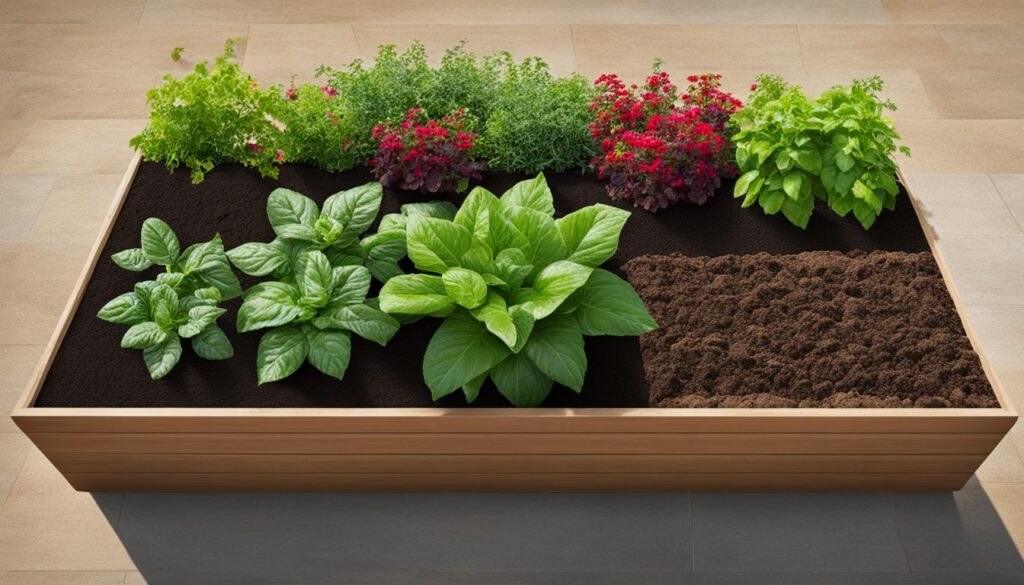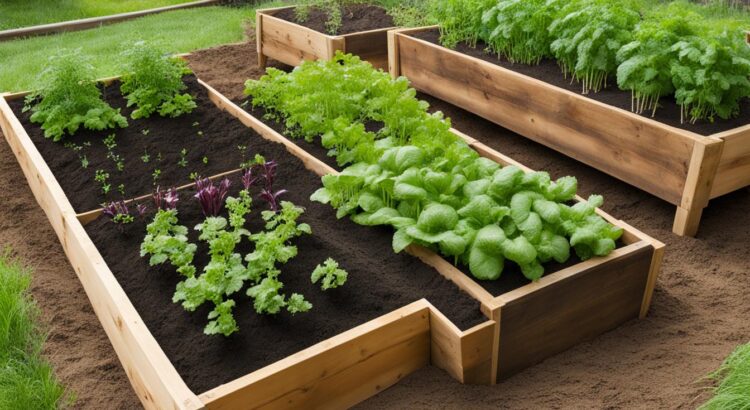How deep should a raised garden bed be depends on the needs of the plants and the gardener. There are different ways to build a raised garden bed, such as double-digging, installing high bed sides, or using a raised planter box. Most plants need about 20 inches of soil depth to thrive, but shallow-rooted plants may only require 12 to 18 inches, while deep-rooted plants may need 24 to 36 inches. Double-digging a patch of ground to a depth of 24 inches is deep enough and thus already meets the soil depth requirement for raised beds. If you’re not double-digging, you can build the sides of the raised bed higher to accommodate the necessary garden soil depth.
Key Takeaways:
- Successful growth of plants in a raised bed garden leans on the depth of your raised garden.
- Most plants require roughly 20 inches of soil depth to grow, but the required root depth can vary based on the type of plant such as radish or weed.
- Shallow-rooted plants may only need 12 to 18 inches of soil depth, while deep-rooted plants may require 24 to 36 inches.
- Consider double-digging or using a higher frame to meet the necessary soil depth requirements.
- Choose the depth of your raised garden based on the needs of your plants and your personal gardening preferences.
Factors to Consider When Determining How Deep Should A Raised Garden Be
When deciding how deep a raised garden bed should be, consider various factors that can influence plant growth and your overall success in gardening. By considering these factors, you can determine how deep your raised bed should be, crafting an environment where your plants grow healthily and abundantly.
Types of Plants:
Different plants have different root system depths, so when you build a raised bed it’s crucial to choose a depth that accommodates the specific needs of your chosen plants. Shallow-rooted plants like lettuce may only require 6 to 12 inches of soil depth, while medium-rooted plants like peppers and cucumbers generally need 12 to 18 inches. Deep-rooted plants like tomatoes, on the other hand, may require a raised bed 18 to 24 inches deep or more, to allow for proper root development. Understanding the depth needs of your plants will help you determine how deep you need to build your raised bed.
Bottom Of A Raised Garden Bed:
The surface underneath the raised bed can also influence the required depth. If the bed is placed on concrete or another type of surface that restricts water flow, taller bed heights may be necessary to ensure proper drainage. This will prevent water from pooling and potentially drowning plant roots. Consider the underlying surface and choose a depth that allows for adequate water drainage to promote healthy plant growth.
Gardener’s Accessibility:
Another factor to consider is the accessibility of the raised bed for maintenance. The height of the bed should be chosen to ensure easy access for the gardener. A taller bed can reduce bending or stooping while working in the garden, making it more comfortable for the gardener to tend to the plants. Take into account your own preferences and physical abilities when determining the depth of your raised bed.
By considering these factors, you can determine the best depth for your raised garden bed. Remember to choose a depth that suits the needs of your plants, takes into account the underlying surface, and provides easy access for maintenance. With the right depth, your raised bed garden will provide an optimal environment for the healthy growth of your plants.
Soil Depth Requirements for Raised Garden Beds
When planning a raised garden bed, it is important to understand the soil depth requirements for optimal plant growth. The depth of the soil in your raised bed will directly impact the health and productivity of your plants. To determine the right depth for your garden bed, consider the types of plants you plan to grow and their specific root system needs.
Shallow-rooted plants, such as lettuce or herbs, typically require a soil depth of 6 to 18 inches. These plants have shorter root systems and can thrive in shallower beds. On the other hand, medium-rooted plants like peppers and cucumbers require a depth of 18 to 24 inches. These plants have longer and more extensive root systems, so they need a deeper bed to support their growth. Deep-rooted plants, like tomatoes, have even longer root systems and require a depth of 24 to 36 inches. These plants need extra space for their roots to spread and establish a strong foundation.
It’s essential to choose the right depth for your raised garden bed to ensure the health and productivity of your plants. Providing adequate soil depth will enable their roots to access nutrients, water, and oxygen, leading to robust growth and bountiful harvests. Remember to consider the specific depth requirements of the plants you plan to grow and adjust your raised bed accordingly.
Soil Depth Requirements for Common Raised Bed Plants
| Plant | Soil Depth Requirement (inches) |
|---|---|
| Lettuce | 6-18 |
| Herbs | 6-18 |
| Peppers | 18-24 |
| Cucumbers | 18-24 |
| Tomatoes | 24-36 |
Keep in mind that these are general guidelines, and individual plant varieties may have slightly different depth requirements. It’s always a good idea to consult seed packets or gardening resources for specific recommendations for the plants you plan to grow.

Choosing the appropriate soil depth for your raised garden bed is crucial for the success of your plants. Take the time to research the specific needs of your chosen plant varieties and adjust the depth of your bed accordingly. By providing the right soil depth, you’ll create an ideal environment for your plants to thrive and produce a bountiful harvest.
Material and Drainage Considerations for DIY Raised Garden Beds
When it comes to creating a raised garden bed, choosing the right materials and ensuring proper drainage are key factors for success. The material used should not only be durable but also complement the overall look of your garden. Common options include metal panels, wood, brick, and stone. However, each material has its pros and cons.
Metal panels are easy to install and provide a sleek, modern look. However, over time, they may rust, which can affect their durability. Wood is a popular choice due to its natural aesthetic, but it tends to rot quickly, especially if it’s not treated or sealed properly. Stone and brick can be more costly options, but they offer long-lasting durability and can give your garden a timeless appearance.
Regardless of the material you choose, proper drainage is essential for the health of your plants. Raised beds typically require at least 8 inches of soil depth to accommodate plant roots and allow for water to drain effectively. One way to ensure good drainage is to use a porous growing medium, such as a mixture of compost and sand, which helps prevent water from pooling in the bed.
Overall, selecting the right material and ensuring proper drainage are crucial considerations when creating a raised garden bed. Take into account factors like durability, aesthetics, and drainage capabilities to create a functional and visually appealing garden space.
| Material | Pros | Cons |
|---|---|---|
| Metal Panels | Easy to install, modern look | Potential rusting over time |
| Wood | Natural aesthetic | Can rot quickly |
| Stone and Brick | Durable, timeless appearance | Higher cost |
Table: Pros and Cons of Raised Garden Bed Materials
Conclusion
The depth of a raised garden bed plays a crucial role in the success of your plants. By determining the right depth, you can provide the ideal environment for healthy growth and bountiful harvests. Most plants require approximately 20 inches of soil depth, but it’s important to consider the specific needs of your chosen plants.
Factors like the surface underneath the bed and your accessibility for maintenance should also be taken into account. Beds resting on concrete or restricted surfaces may require taller heights for improved drainage. Additionally, choosing a bed height that allows for easy access can reduce strain on your back and knees.
In conclusion, understanding the depth requirements for raised bed gardening is essential for creating a thriving garden. By considering the needs of your plants, the surface underneath the bed, and your own accessibility preferences, you can determine the ideal depth and ensure optimal growing conditions for your raised bed garden.
FAQ
How deep should a raised bed garden be?
The depth of a raised garden bed depends on the needs of the plants and the gardener. Most plants need about 20 inches of soil depth to thrive, but shallow-rooted plants may only require 12 to 18 inches, while deep-rooted plants may need 24 to 36 inches.
What factors should be considered when determining raised bed depth?
When deciding on the depth of a raised garden bed, it’s important to consider factors like the kinds of plants you want to grow, the surface underneath the bed, and the accessibility of the bed for maintenance.
What are the soil depth requirements for raised garden beds?
Different plants have different root system depths, so when you build a raised bed it’s crucial to choose a depth that accommodates the specific needs of your chosen plants. Shallow-rooted plants like lettuce may need 6 to 18 inches, medium-rooted plants like peppers and cucumbers may require 18 to 24 inches, and deep-rooted plants like tomatoes may need 24 to 36 inches of soil depth.
What are the material and drainage considerations for raised garden beds?
The material used for a raised garden bed should be durable, attractive, and stable. Common materials include metal panels, wood, brick, and stone. Drainage is also a crucial consideration, with raised beds typically requiring at least 8 inches of soil depth to accommodate plant roots and allow for proper drainage.
